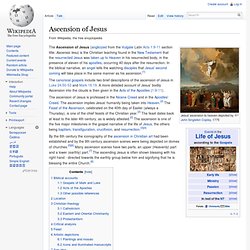

Ascension of Jesus. By the 6th century the iconography of the ascension in Christian art had been established and by the 9th century ascension scenes were being depicted on domes of churches.[5][6] Many ascension scenes have two parts, an upper (Heavenly) part and a lower (earthly) part.[7] The ascending Jesus is often shown blessing with his right hand - directed towards the earthly group below him and signifying that he is blessing the entire Church.[8] Biblical accounts[edit] Gospels of Mark and Luke[edit] "after he had spoken unto them, was received up into heaven, and sat down at the right hand of God.

" However, based on strong textual and literary evidences, biblical scholars no longer accept Mark 16:9-20 as original to the book.[12] Rather, this section appears to have been compiled based on other gospel accounts and appended at a much later time. Nebuchadnezzar II. Nebuchadnezzar II ( i/nɛbjʉkədˈnɛzər/; Aramaic: ܢܵܒܘܼ ܟܘܼܕܘܼܪܝܼ ܐܘܼܨܘܼܪ ; Hebrew: נְבוּכַדְנֶצַּר Nəḇūḵaḏneṣṣar; Ancient Greek: Ναβουχοδονόσωρ Naboukhodonósôr; Arabic: نِبُوخَذنِصَّر nibūḫaḏniṣṣar; c 634 – 562 BC) was king of the Neo-Babylonian Empire, who reigned c. 605 BC – 562 BC.

He is credited with the construction of the Hanging Gardens of Babylon and for the destruction of the First Temple.